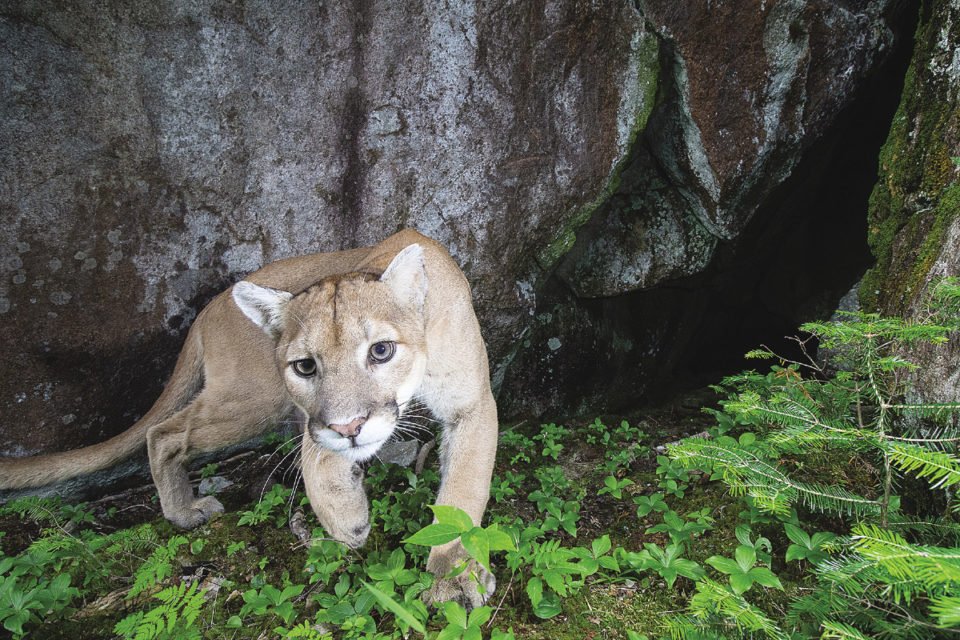Years ago, I was driving across the Shoe Lake Road north of Hovland on a late October afternoon. A fresh dusting of snow, unmarked by tire tracks, covered the road. I noticed a large set of paw prints crossing the road and stopped to investigate them, thinking they were left by a wolf. The tracks were wolf-sized, round and indistinct. Curious, I followed the tracks into the woods a short distance until I came to a place where the critter made a four-point jump onto a fallen log and then walked down the log like a gymnast on a balancing beam.
Wolves don’t do that. Cats do.
I didn’t have time to follow the tracks any farther, so I walked back to the truck and continued on my way. I don’t know what sort of cat made the tracks, but since then I have seen Canada lynx and their tracks nearby on several occasions. Perhaps the tracks I saw were left by a lynx; an animal with big, furry feet. But it is possible they were left by a mountain lion.
In a lifetime spent roaming the wilds of northeastern Minnesota in all seasons, I’ve never seen a mountain lion. I’ve heard plenty of stories about sightings by other people ranging from fleeting glimpses to fanciful accounts of the “black panthers” that “everyone knows” are out there. Most often, these stories are told by folks who spend little time in the woods and are unaware that that melanistic (black color phase) mountain lions don’t exist. The only melanistic big cats are jaguars, which range along the Mexican border, and leopards of Africa and Asia. If either of those cats showed up in the Northwoods, it would have a domesticated origin.
From dozens of supposed sightings, I’ve only heard a small handful of mountain lion stories from folks who were credible observers. None of them had photos of the animals or their tracks. Then along came Ryan Pennesi, who captured eight photos of mountain lion at his camera trap in Lake County at 7:44 a.m. July 24. As you can see from the accompanying photo, there is no doubt the animal is a mountain lion.
A reforestation technician for the U.S. Forest Service at Tofte, Pennesi has been setting camera traps for eight years. He sets them in locations animals, particularly carnivores, are likely to investigate. He sets the camera, along with two or three flash units, at a place where terrain and vegetation will cause animals to funnel through a pinch point. With batteries lasting about a month, he visits the camera traps infrequently to avoid alerting local wildlife to his presence.
The location where he photographed the mountain lion was a small cave in a rocky area that had already proven to be attractive to a range of critters. He’s taken excellent photos of bobcats there, as well as black bear, racoons, porcupines, red squirrels, chipmunks and even a Franklin’s ground squirrel. He didn’t expect his menagerie of photos would include a mountain lion.
“I was very surprised,” he said.
Pennesi reported his photo capture to Minnesota DNR wildlife staff, who asked him to not give out the specific location where it was taken. He was told mountain lions exist in the state, but are uncommon. Wildlife officials believe the big cats seen in Minnesota originate in the western Dakotas and are young males seeking new territory to claim as their own. He has doubled his camera trapping efforts in the vicinity, but isn’t hopeful that he will capture any more photos.
Interestingly, five years ago he found scat he thought was possibly from a cougar that he turned in for DNA testing, which determined it was from a bobcat. He’s also talked with two people who described mountain lion sightings they had in the past five years not far from where he took the picture.
Pennesi isn’t the only person to encounter mountain lions in Minnesota this year. DNR large carnivore specialist Dan Stark said he has received nine verified occurrences since January. This tops the eight occurrences recorded in 2018. Only two were recorded last year. This year’s occurrences began with a January report near Nebish in Beltrami County, followed by one southeast of Grand Forks in February. In May, a couple of trail camera images were reported in Ottertail County, with subsequent reports from Itasca and Cass counties. Stark believes some reports may be of the same animal as it roams. Pennesi’s capture is the first recent report on the North Shore, although reports came from Skibo and Hoyt Lakes as well as Grand Marais a few years ago.
“We’ve had photos from just about everywhere in the state,” Stark said. “We’ve even had a few mountain lions show up dead.”
Scientific analysis has determined the dead animals, all males, originated in the Black Hills, northwestern Nebraska, Wyoming and Montana. The DNR has been keeping track of mountain lion reports since 2007, collecting over 50. In the past, DNR wildlife staff did site verification visits, but as observations become more common and DNR adjusts work priorities at field offices, those visits will be more limited.
Stark believes mountain lions just pass through Minnesota and don’t stick around.
“We haven’t seen any evidence of a resident population,” he said.
The lack of evidence is compelling. Extensive surveys for wolves and other forest predators haven’t detected any mountain lions. None have ever been caught in traps or snares. Also, aside from a very few isolated occurrences, mountains lions don’t turn up as road kills. Stark said that places with small, established mountain lion populations can have dozens of vehicle-kills every year.
The DNR doesn’t dispute mountain lion sightings reported by the public, but only verifies physical evidence such as photos or tracks. There have been reports of deer kills by cats, which are identified by the deer being partially buried. However, when biologists have set up trail cameras at the kill sites, they have photographed bobcats returning to the kill. Stark said bobcats are capable of killing deer and will cache their kill.
Because female mountains rarely disperse far from where they were born, Stark believes it will be years, if ever, before mountains lions establish a breeding population in Minnesota. But given their abundance a few hundred miles to the west, it is likely roaming males will continue to be sighted in the state.
Pennesi plans to keep setting camera traps and capturing images that add to our knowledge of North Shore wildlife. For instance, wildlife biologists were surprised when he captured photos of a badger. Since then, he has photographed several of the animals. While he does sell some photographs, Pennesi’s camera trapping is more a labor of love than a business.
“I hope that my work inspires others to seek out their own adventures outdoors and to be curious observers in nature,” he said.




